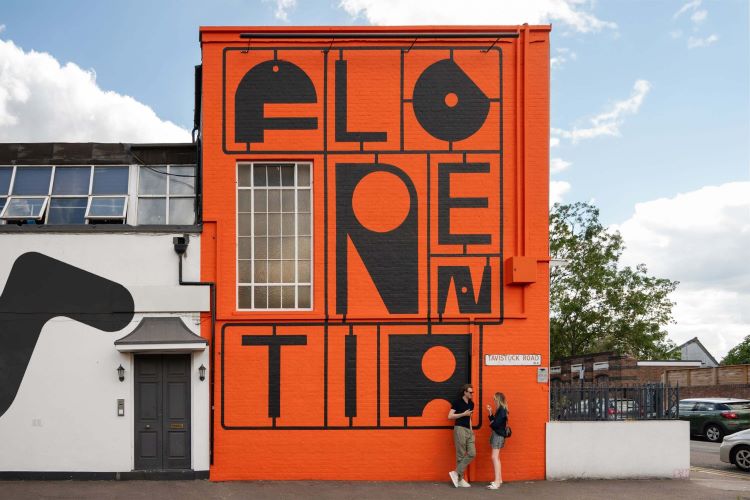Florentia Village identity references model making and manufacturing
DNCO devised a series of graphic devices for the creative maker space that act as “a metaphor for how Florentia Village is there to support and connect the creative tenants”.
DNCO has designed the identity for Florentia Village – a community of makers and design-led businesses – devising the “sprue framework” inspired by punch-out kits found in model making and manufacturing.
The north London warehouse started as a textile manufacturing centre in the 1970s and is now home to over 40 makers and design-led businesses. General Projects – the site’s developer – approached DNCO with the aim of building a brand that would reflect Florentia Village’s future expansion plans, which include the addition of over 8361 square metres of new facilities.

DNCO founder and executive chair Joy Nazzari admits that she hadn’t previously heard of Florentia Village but was “blown away by the history and the self-made nature” of the community. “With so many of these kinds of spaces being turned into residential, we had an opportunity to help its survival as a creative space”, she adds.
While the community is now home to a mix of businesses, from bike makers to jewellery designers and independent florists, the studio built a strategy which reflects on its past, according to DNCO senior strategist Brenda Sjahrial. This includes its establishment as a manufacturing centre as well as the industrial legacy of the space, which sits within the Harringay Warehouse District.
Taking inspiration from punch-out kits often found in model making and manufacturing, DNCO senior designer Maria Hamer says the studio designed “the sprue framework”, referring to “the connecting parts within plastic and metal moulds” by which materials are poured in. This exists to house key messaging and act as “a decorative border”, Hamer adds, explaining how DNCO saw it as “a metaphor for how Florentia Village is there to support and connect the creative tenants”.
Seeking to foreground “the notion of craft” without it looking “too literal or pastiche”, DNCO designed a series of abstract letterforms based on “the obscure and often unnoticed mechanical parts found in manufacturing”, says Hamer. She describes how the letterforms are “fundamental to creating a playful and distinct identity for Florentia Village”.
Florentia Village’s logo was devised with adaptability in mind, according to Hamer, as the studio created a suite of custom letterforms that can be swapped and changed as required. Hamer adds that it can be used at all scales and mediums and can appear both “more reserved” and at other times “bolder and more heroic”.
In collaboration with General Projects and architects Turner Works, DNCO sought to produce a colour palette with the ability to stand out against “the already colourful Harringay Warehouse District, while also complementing the current and future Florentia Village development”, says Hamer. A combination of vivid blue, pink, coral red and green hues make up the palette, chosen to “pop against each other” and “add to the energy behind the brand”, Hamer explains.

DNCO also created a holding page for Florentia Village, which will include content about upcoming events, stories of makers in the community and updates about General Projects’ plans for the site. Sjahrial says there is “a richer, more interactive version of the website in the works”.
In addition to signage and online, the graphic language appears in 10 mural artworks for the community, which Hamer says was one of the biggest challenges.
-
Post a comment





